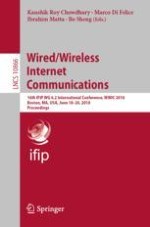2018 | OriginalPaper | Buchkapitel
Evolutionary-Based Coverage Control Mechanism for Clustered Wireless Sensor Networks
verfasst von : Riham Elhabyan, Wei Shi, Marc St-Hilaire
Erschienen in: Wired/Wireless Internet Communications
Aktivieren Sie unsere intelligente Suche, um passende Fachinhalte oder Patente zu finden.
Wählen Sie Textabschnitte aus um mit Künstlicher Intelligenz passenden Patente zu finden. powered by
Markieren Sie Textabschnitte, um KI-gestützt weitere passende Inhalte zu finden. powered by
